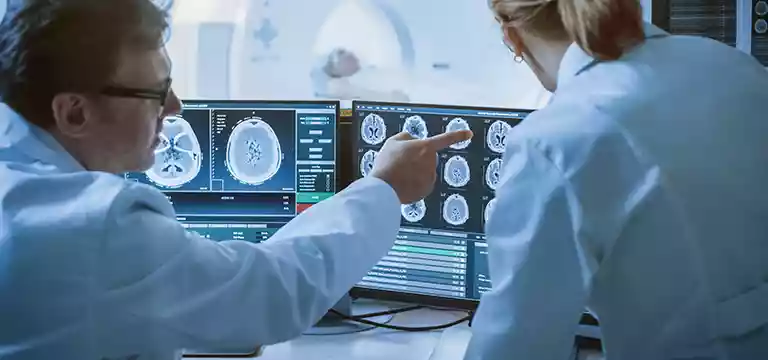
Discover how CT scans enhance the success of minimally invasive procedures. Learn about the benefits, applications, and advancements in CT technology. Choose Ganesh Diagnostics, the best diagnostic center for CT scans for...
Introduction
Minimally invasive procedures have revolutionized modern medical practices by offering patients less invasive alternatives to traditional surgical methods. These procedures are associated with shorter hospital stays, reduced pain, and faster recovery times. A key component in the success of minimally invasive procedures is the use of computed tomography (CT) scans. CT scans provide detailed anatomical information, aid in precise localization, and enhance the accuracy of needle placements. In this article, we will explore how CT scans play a vital role in guiding minimally invasive procedures, ensuring optimal patient outcomes.
Understanding Minimally Invasive Procedures
Minimally invasive procedures involve using small incisions or natural body openings to access the targeted area, as opposed to large incisions required in traditional surgery. These procedures offer several advantages, including reduced blood loss, minimal scarring, decreased postoperative pain, and shorter recovery times. Various medical specialties, such as cardiology, gastroenterology, and radiology, utilize minimally invasive techniques for diagnostic and therapeutic purposes. Accurate imaging plays a crucial role in guiding these procedures and ensuring their success.
The Role of CT Scans in Minimally Invasive Procedures
CT scans, also known as computed tomography, utilize a combination of X-rays and computer processing to create detailed cross-sectional images of the body. These scans provide high-resolution images that aid physicians in visualizing internal structures with exceptional clarity. In the context of minimally invasive procedures, CT scans serve as invaluable tools for guiding the entire process, from pre-procedural planning to real-time guidance during the procedure itself.
CT scans offer several benefits when guiding minimally invasive procedures. They provide precise anatomical information, allowing physicians to identify target areas accurately. This information helps determine optimal entry points, assess potential risks, and select appropriate instruments. Additionally, CT scans offer real-time visualization, allowing physicians to monitor needle placements and make necessary adjustments for optimal accuracy. This level of guidance enhances the overall success rates of minimally invasive procedures.
Preparing for Minimally Invasive Procedures with CT Scans
Before undergoing a minimally invasive procedure, proper preparation is essential to ensure patient safety and procedural success. CT scans play a vital role in this preparatory phase. By utilizing CT scans, physicians can assess the patient's anatomy, identify potential complications, and plan the procedure accordingly. These scans assist in determining the optimal approach, identifying critical structures to avoid, and evaluating the patient's suitability for the procedure.
The advantages of CT scans in pre-procedural planning are manifold. They help physicians visualize the target area from multiple angles, ensuring a comprehensive understanding of the patient's anatomy. This information allows for accurate selection of entry points, minimizing the risk of complications. CT scans also aid in evaluating the proximity of critical structures, such as blood vessels and nerves, enabling the physician to navigate around them safely. By utilizing CT scans during the preparation phase, physicians can optimize the procedural approach, leading to improved patient outcomes.
CT-Guided Biopsies and Aspirations
CT-guided biopsies and aspirations involve using CT scans to precisely target abnormal tissues or fluid collections for diagnostic or therapeutic purposes. These procedures offer numerous advantages, including reduced invasiveness, improved accuracy, and minimal scarring. CT scans play a pivotal role in guiding these procedures by providing real-time imaging and accurate localization.
During a CT-guided biopsy or aspiration, the patient lies on a specialized CT table, and the target area is precisely identified using the CT images. The physician uses these images as a guide to insert a needle or catheter with precision into the target area, avoiding surrounding healthy tissues. The real-time imaging capabilities of CT scans ensure accurate needle placement, reducing the need for multiple attempts and minimizing the risk of complications. CT-guided biopsies and aspirations have become standard procedures in diagnosing and treating various conditions, including cancer, abscesses, and cysts.
CT-Guided Pain Management Procedures
Chronic pain conditions often require precise interventions to provide relief and improve a patient's quality of life. CT-guided pain management procedures, such as nerve blocks and facet joint injections, have gained popularity due to their accuracy and efficacy. These procedures involve injecting medications directly into the affected areas under the guidance of CT scans.
CT-guided pain management procedures offer significant benefits over traditional methods. The use of CT scans allows physicians to visualize the targeted nerves, joints, or structures accurately, ensuring precise needle placement. This precision maximizes the effectiveness of the injected medications, providing targeted pain relief. Additionally, CT-guided procedures reduce the risk of complications by minimizing the potential damage to surrounding tissues. Patients suffering from chronic pain conditions can experience improved pain control and enhanced functionality with these minimally invasive techniques.
Advancements in CT Technology for Minimally Invasive Procedures
Continuous advancements in CT technology have further improved the accuracy and success of minimally invasive procedures. Two notable advancements are cone-beam CT and dual-energy CT.
Cone-Beam CT
Cone-beam CT technology provides volumetric imaging with a cone-shaped X-ray beam, enabling high-resolution three-dimensional images of the targeted area. This advancement offers enhanced visualization and improved accuracy, particularly in complex anatomical regions. Cone-beam CT is particularly beneficial in image-guided interventions, such as spinal procedures and image-guided radiation therapy.
Dual-Energy CT
Dual-energy CT utilizes two different X-ray energy levels to generate images with improved tissue characterization. This technology enhances the visualization of soft tissues, enabling better differentiation between various structures. Dual-energy CT is especially valuable in vascular imaging, oncology, and evaluating musculoskeletal disorders.
These advancements in CT technology empower physicians with better imaging capabilities, reduced radiation exposure, and enhanced procedural guidance. As technology continues to evolve, the accuracy and success rates of minimally invasive procedures are expected to improve significantly.
Why Ganesh Diagnostics is the Best Diagnostic Center for "CT Scans Aid in Guiding Minimally Invasive Procedures
- State-of-the-art CT scanning facilities
- 24/7 availability for patient convenience
- Multiple panels available for comprehensive imaging needs
- Seven branches across Delhi, conveniently located for easy accessibility
Conclusion
CT scans play a pivotal role in guiding minimally invasive procedures, ensuring accurate targeting, and improving patient outcomes. The precise anatomical information provided by CT scans allows physicians to plan procedures effectively, minimize complications, and enhance procedural success rates. Ganesh Diagnostics is the best diagnostic center for CT scans for guiding minimally invasive procedures. With state-of-the-art facilities and a team of experienced professionals, Ganesh Diagnostics offers comprehensive imaging services to support minimally invasive interventions. Choose Ganesh Diagnostics for accurate CT scans and optimal guidance in your minimally invasive procedures.
FAQs
How do CT scans aid in guiding minimally invasive procedures?
CT scans provide detailed anatomical information, enabling precise localization and accurate needle placements during procedures.
What are the advantages of minimally invasive procedures over traditional surgery?
Minimally invasive procedures offer reduced blood loss, minimal scarring, decreased postoperative pain, and shorter recovery times compared to traditional surgery.
How do CT-guided biopsies and aspirations enhance accuracy in diagnosis and treatment?
CT scans allow precise targeting of abnormal tissues or fluid collections, reducing invasiveness, improving accuracy, and minimizing scarring.
How can CT-guided pain management procedures benefit patients with chronic pain conditions?
CT-guided techniques ensure accurate needle placement, maximizing the effectiveness of injected medications and providing targeted pain relief.
What advancements in CT technology have improved minimally invasive procedures?
Advancements such as cone-beam CT and dual-energy CT offer enhanced imaging capabilities, reduced radiation exposure, and improved procedural guidance.









